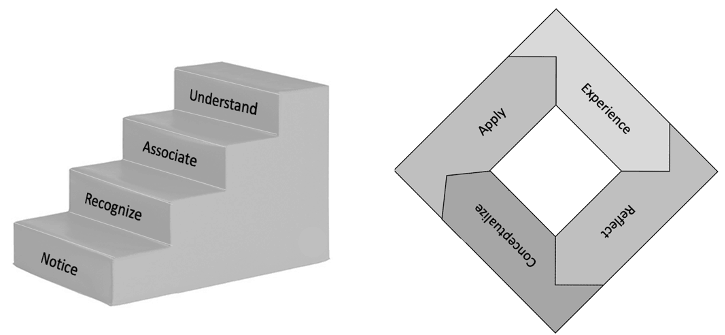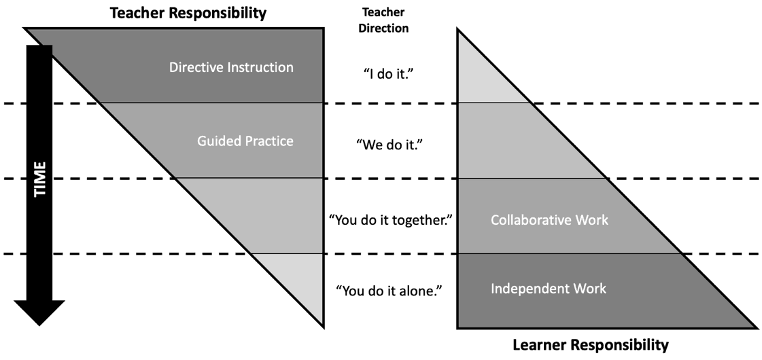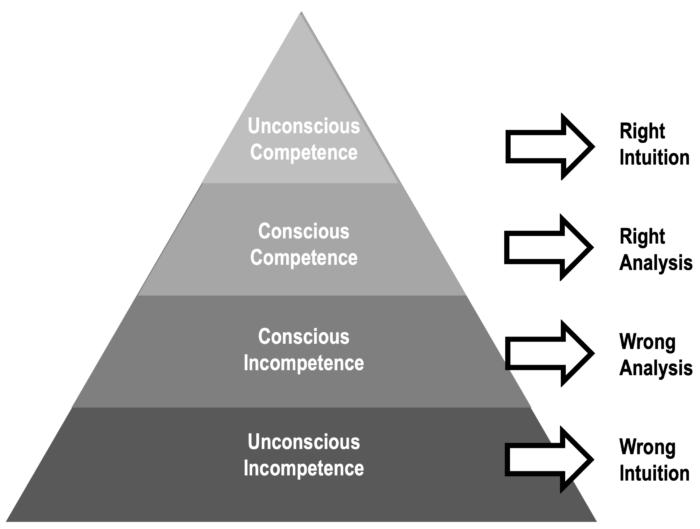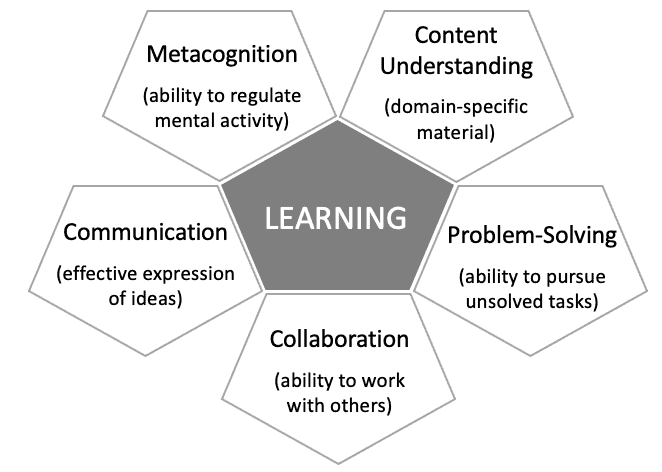AKA
Learning Hierarchies
Learning Taxonomies
Types of Learning
Focus
Differentiated and ranked levels of thought and skillPrincipal Metaphors
- Knowledge is … established facts and creative possibilities based on those facts
- Knowing is … recalling (to apply, analyze, evaluate, create)
- Learner is … a student
- Learning is … remembering and performing
- Teaching is … structuring experiences (to engage all cognitive levels)
Originated
1950sSynopsis
Levels of Learning Models focus on what is to be learned rather than how learning happens. Typically, such models are generic (i.e., not discipline specific; contrast with Stages of Understanding Models), and they tend to be presented as hierarchies, trajectories, sequences, or cycles, as exemplified by the following generic images: Ubiquitous notions across Levels of Learning Models include:
Ubiquitous notions across Levels of Learning Models include:
- Higher-Order Thinking (Higher-Order Cognition; Higher-Order Thinking Skills; HOTS) – a construct that is common across Levels of Learning Models and other learning taxonomies. The notion of Higher-Order Thinking is typically applied to the more sophisticated or demanding modes of thinking across such models.
- Strategic Learning – a phrase that is subject to a wide range of interpretations, but that when used in education most often refers to efforts and strategies designed to improve learner autonomy through the development of more sophisticated learning/thinking strategies (which are typically defined in terms of specific Levels of Learning Models)
- Revised Bloom’s Taxonomy (David Krathwohl, 2000s) – a two-dimensional model by adding a “Knowledge Dimension” to the cognitive processes identified in Bloom's Taxonomy, resulting in many more, finer-grained categories of consideration:

- Hierarchy of Learning Types (Robert M. Gagné, 1960s) – an 8-level typology of learning events
- Signal Learning: learn to respond to an arbitrary signal
- Stimulus-Response Learning: learn precise responses to precise signals
- Chaining: learn procedures by chaining stimulus-response learnings
- Verbal Association: use words in verbal chains
- Discrimination Learning: learn to distinguish between similar stimuli
- Concept Learning: identify entire classes of stimuli for single responses
- Principle Learning: learn to apply rules
- Problem Solving: flexibly apply learnings to unfamiliar challenges
- Levels of Competence (German Education Council [Deutscher Bidungsrat], 1970s) – a 4-category taxonomy of learned competencies.

- Modes of Learning (D. Rumelhart & D. Norman, 1970s) – three modes of learning
- Accretion: adding new knowledge (the most common type of learning)
- Structuring: forming new conceptual structures (less common than accretion, and requiring more effort)
- Tuning: adapting established knowledge to a specific task (slowest type, and involved in expert performance)
- Gradual Release of Responsibility Model (D. Fisher & N. Frey, 2010s) – a combining of levels of learned competence with (1) types-and-extents of the teacher’s actions and (2) types-and-extents of student engagements, designed to support the suggestion that teacher control should diminish as learner competence develops.

- Conscious Competence Model of Learning (Martin M. Broadwell, 1960s) – interprets the movement from unskilled to skilled in terms of four discrete stages

- Three Stages of Motor Skill Learning (Three Stage Theory) (Paul Fitts & Michael Posner, 1960s) – a 3-level trajectory of in the development of physical skills

- CRESST Learning Model (Eva Baker of the Center of Research on Evaluation, Standard, and Student Testing; 1990s) – a composite of prior taxonomies, aiming to describe five kinds of learning

- Depth of Knowledge (Webb’s Depth of Knowledge) (Norman Webb, 1990s) – a four-level taxonomy of the complexity of thinking required for various tasks: Level 1. Recall and Reproduction (recall of facts; application of familiar procedures); Level 2. Skills and Concepts (decision-making required to compare, organize, predict, etc.); Level 3. Strategic Thinking (planning and justification required to solve non-routine problems, design an experiment, etc.); Level 4. Extended Thinking (synthesizing information from multiple sources over time)
- Cognitive Rigor (Cognitive Rigor Matrix) (Karin Hess, 2000s) – a crossing of the six levels of Bloom's Taxonomy with the four levels of Webb’s Depth of Knowledge (see above), giving a 4-by-6 matrix that is intended to inform curriculum development and lesson planning
Commentary
The metaphor of “levels” is ubiquitous in western formal education. Other usages include:
- Ability Level – a description of how well one can perform a task or understand a subject. Most commonly, Ability Levels are expressed informally on a continuum of beginner to expert, but literally thousands of formal tests have been developed to measure achievement and performance across hundreds of abilities.
- Age Level – the developmental appropriateness relative to chronological age, typically defined in terms of “developmental benchmarks” associated with a particular age group
- Developmental Level – a broad notion that looks across physical, emotional, and cognitive maturity, along with experiential and academic background (See more under Developmental Discourses.)
- Frustration Level – the point at which a concept or task is experienced as incomprehensible or too difficult
- Grade Level – a curriculum-design construct, specifying what an educational system expects one to achieve in a given grade
- Independent Level – the point at which one can successfully complete a task without any assistance
- Instructional Level – the match between learner’s current ability and the difficulty of instructional materials/tasks, sometimes defined as the point at which material is challenging but not frustrating (See Goldilocks Task, under Flow and Zone of Proximal Development, under Socio-Cultural Theory.)
- Readiness Level – the combination of prior knowledge, skills, and developmental maturity needed to succeed with a given learning task (See more under Authentic Learning.)
Authors and/or Prominent Influences
Diffuse. Illustrative cases as stated above.Status as a Theory of Learning
Levels of Learning Models do not engage with issues around the complex dynamics of learning, and so are not considered learning theories in this analysis.Status as a Theory of Teaching
Levels of Learning Models are principally theories of teaching, most often employed in articulating learning outcomes for lessons and courses.Status as a Scientific Theory
Levels of Learning Models tend to fall short on most of our criteria for scientific status.Subdiscourses:
- Ability Level
- Age Level
- Cognitive Rigor (Cognitive Rigor Matrix)
- Conscious Competence Learning Model
- CRESST Learning Model
- Depth of Knowledge (Webb’s Depth of Knowledge)
- Developmental Level
- Frustration Level
- Gradual Release of Responsibility Model
- Grade Level
- Hierarchy of Learning Types
- Higher-Order Thinking (Higher-Order Cognition; Higher-Order Thinking Skills; HOTS)
- Independent Level
- Instructional Level
- Levels of Competence
- Modes of Learning
- Readiness Level
- Revised Bloom’s Taxonomy
- Strategic Learning
- Three Stages of Motor Skill Learning (Three Stage Theory)
Please cite this article as:
Davis, B., & Francis, K. (2025). “Levels of Learning Models” in Discourses on Learning in Education. https://learningdiscourses.com.
⇦ Back to Map
⇦ Back to List
